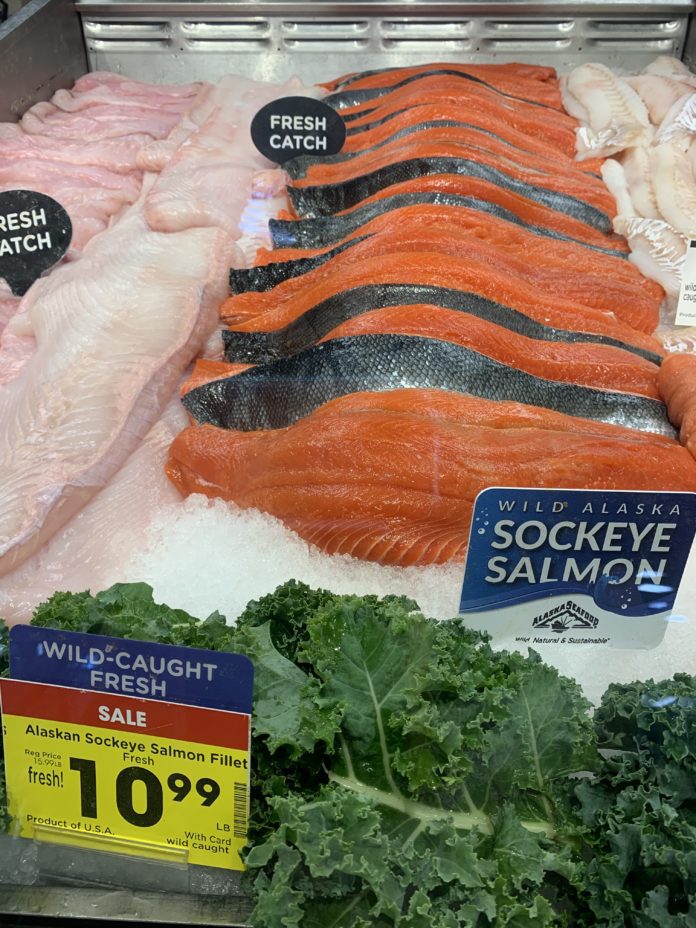
Millions of wild salmon heading for their spawning grounds in Alaska are being greeted by commercial fishermen with drift gillnets and setnets, harvesting upwards of 14 million fish through Tuesday morning, including over four million in Prince William Sound.
For the Copper River District itself over 601,000 salmon were delivered to processors and the state’s central region had an overall catch of over 11.6 million fish.
Preliminary data compiled by the Alaska Department of Fish and Game put the catch through Tuesday at over 14 million fish harvested statewide, including 10.3 million sockeyes, 3.3 million chums, 331,000 pink, 46,000 Chinook, and 6,000 coho salmon.
In Prince William Sound, the Copper River District had a total of 576,948 sockeyes, 19,024 chums, 9,825 Chinooks, 1,685 pinks and 856 cohos in a total of 3,420 deliveries. The Eshamy Main Bay drift/setnet district had 321,841 sockeyes, 73,268 chums, 5,501 coho, 836 pinks, and 30 Chinooks in 1,681 deliveries. The Coghill District had 115,109 sockeyes, 617,487 chums, 1,154 pinks, and 107 Chinooks in 2,659 deliveries.
The Montague Drift gillnet district led the chum harvest with 803,093 chums, plus 23,770 sockeyes, 43,729 pinks, and 146 Chinooks.
The overall district preliminary catch came in at 1,080,221 reds, 1,613,152 chums, 50,200 pinks, 10,152 Chinooks, and 6,391 coho salmon.
In Bristol Bay, the catch has reached 7.3 million fish, including 7,261,000 sockeyes and 5,000 chums.
The bulk of the catch was coming in from the Egegik District, followed by the Naknek-Kvichak, and harvest was starting to build in the Ugashik and Togiak districts, but there were no preliminary reports yet in the Nushiagak District.
Cook Inlet harvesters had over 204,000 sockeyes, mainly in the southern district.
In the state’s westward region, the total preliminary catch had reached 2.1 million fish, including 1.7 million fish in the Alaska Peninsula and 378,000 in the Kodiak region, mostly sockeyes.
The overall Alaska salmon harvest was down about 19% from 2022 through Statistical Week 26,
noted Sam Friedman, a seafood consultant to McKinley Research Group, which produces the weekly
in-season updates on salmon harvests for the Alaska Seafood Marketing Institute.
Bristol Bay harvesters are forecast to catch 37 million sockeye salmon this year, with the harvest
peaking in the next few weeks, Friedman said. Although the 2023 Bristol Bay forecast is considerably
less than the record 2022 harvest, the decline in fish counts may be partially counteracted by larger
fish. Bristol Bay sockeye are averaging 5.6 pounds this year, the Port Moller Test Fishery reported, up
from a regional average of 5.1 pounds a year ago.
The keta harvest remains above that of a year ago and five-year-average harvests to date, although
the pace of harvest fell last week. Some 800,000 keta were caught statewide last week, well under
the five-year-average for this week of 1.2 million keta, Friedman noted.
Prices varied, as supermarket seafood shops were displaying refreshed 2022 sockeyes on their showcases along with the fresh catch.
In Anchorage supermarkets the price ranged for shoppers with a store membership card as low as a sale price of $10.99 a pound for fresh Alaska sockeyes to $15.99 a pound for refreshed sockeyes for those lacking membership cards.
The famed Pike Place Fish Market in Seattle was offering fillets of wild Alaska sockeyes at $29.99 a pound and fillets of wild kings at $49.99 a pound. 10th & M Seafoods in Anchorage was busy with sales of fresh Alaska wild sockeyes at $12.95 a pound, and New Sagaya, another popular Anchorage seafood counter, was offering five pounds of fresh wild sockeye fillets for $199.





